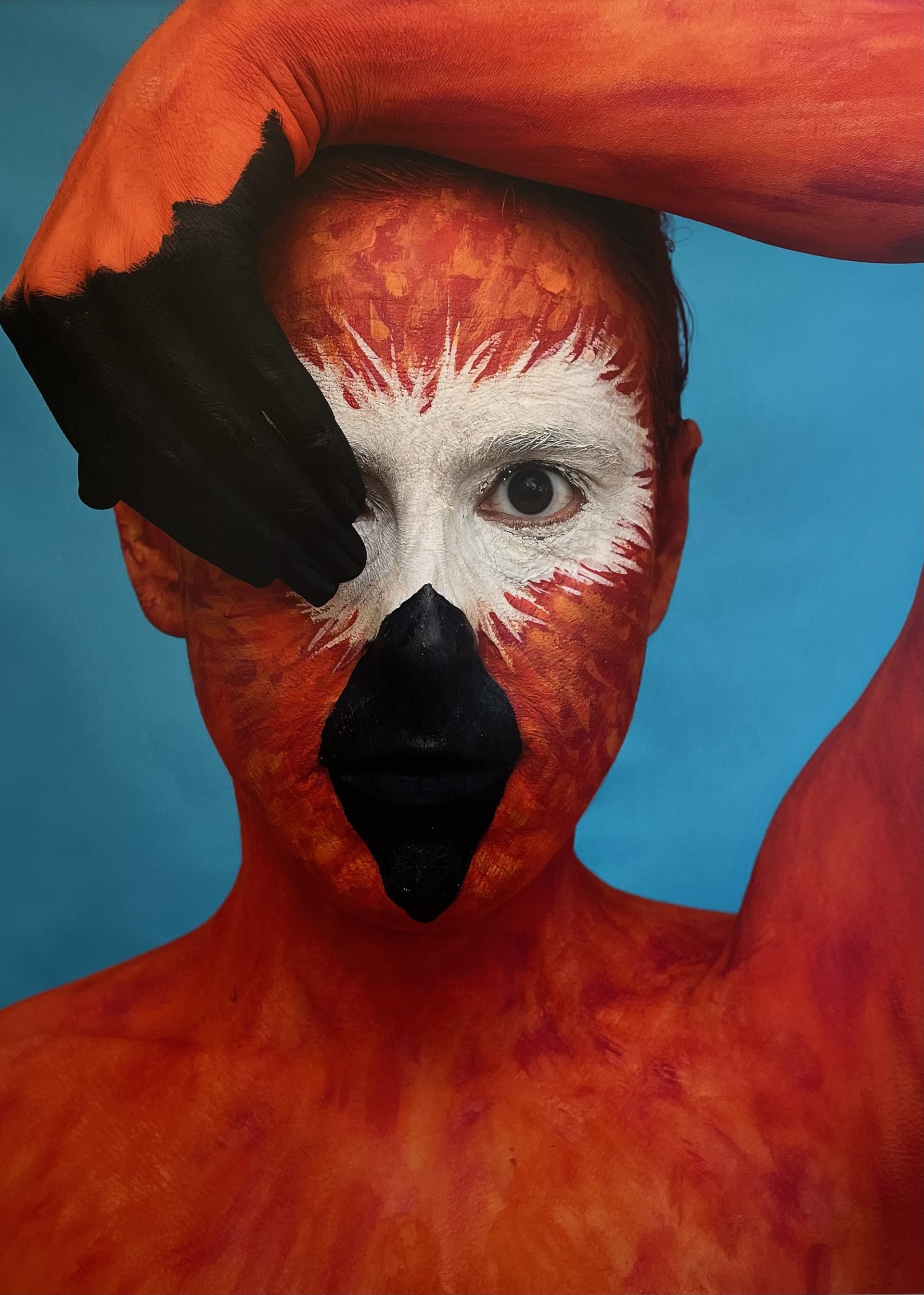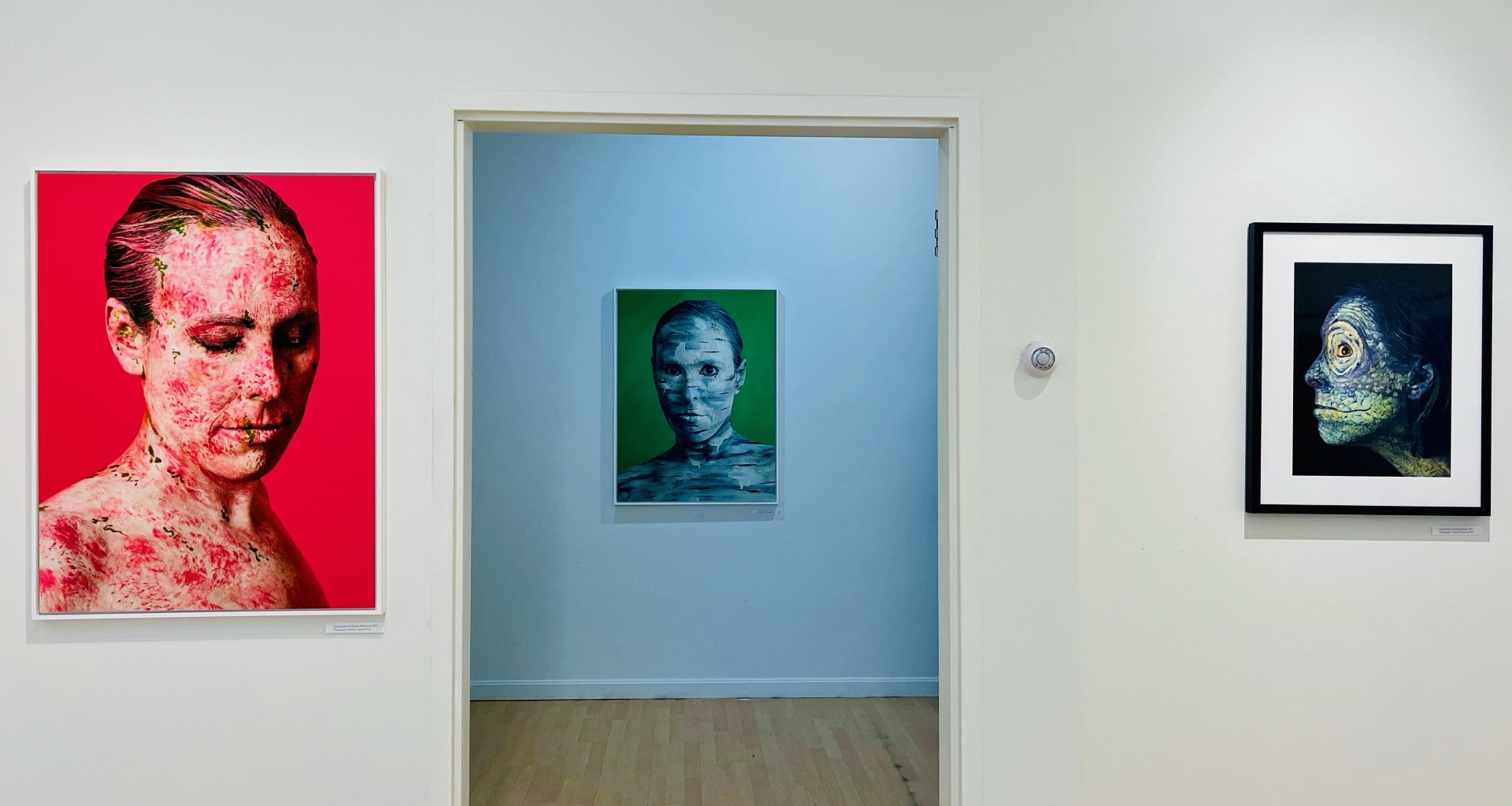Shelby Meyerhoff Models Environmental Art at 4Cs
by Tribekah Jordan
Shelby Meyerhoff puts herself into her art in more ways than one.
The artist, whose work is on exhibit at the 4Cs Higgins Art Gallery through April 11 through April 20, has a detailed art process. Meyerhoff’s multidisciplinary process entails using herself as the canvas. She paints on her body in various colors, and presents herself as either an animal, plant, or another dimension. Once the painting portion is complete, she photographs herself in her new form. Meyerhoff sat down for a discussion surrounding her art on the first day of the exhibit.

Shelby Meyerhoff artwork. (Tribekah Jordan)
Q: Where did the inspiration for these pieces come from?
A: I had been working on environmental issues but also started to get interested in my own local habitat. I live in the Middlesex Fells which is a large, protected nature reservation North of Boston. I became interested not only in the global side or regional issues that were environmental, but in my personal connection to the natural world as a human being – and a species among other species. Then, in terms of materials, I used to love to perform in theater when I was younger. I still love public speaking, being on stage and the magic of transformation. I got really interested in face and body painting as a material. So, these two materials come together at the right moment.
Q: Have you always been drawn to photography?
A: I was a bit daunted by photography. I knew that photography could be a very technical and meticulous art form. When I was in high school, I would do a lot of work with watercolor. Watercolor was always my favorite due to the possibilities of looseness, spontaneity, and flow. It took me some time as I started to see how this work was coming together … A combination of painting, performance, and photography, to realize photography was going to be integral. To have it be as powerful as it needed to be, I would have to take courses and be in critique groups with other photographers. I was lucky that the Griffin Museum of photography was located near my home. When I was pregnant and had my child at home, I was still in that community, learning from people who were more knowledgeable in the art of what makes a great photograph.
Q: What does self-expression mean to you?
A: One of the things that I love about this work is that it gives me freedom to explore a really wide range of emotions. There’s a lot of freedom and possibility in that. We’re seeing a time where there’s an explosion of self-portraiture, and the means to not only produce the portraiture but to gain visibility for it. It’s a wonderful thing that making and sharing self-portraiture has become part of our social way of being now. It can also come with pressure. Any time we put an image of ourselves out into the world there’s a vulnerability there. Another thing that’s interesting about self-expression, when looking back at the history of art and acknowledging not only who has the access to make self-portraiture, but, even when people have made self-portraiture, whose portraiture ends up getting visibility. An exciting possibility for the time now, is that there will be a greater opportunity to appreciate the self-portraiture of many different identities.
Q: Is there a message or feeling you hope to invoke through your art?
A: Across the 2017 series there is room for many different feelings. There is room for feelings that feel like they can’t even co-exist. For example, a sense of wonder and joy in being in nature. A sense of appreciating the nature that we have while also feeling deep anxiety because our natural world is imperiled. The well-being of humanity and species all around us are imperiled. I hope the work has enough range to invite viewers to explore a wide variety of feelings.
Q: This collection, “all things are connected,” is based on nature and the celebration of life. Is there anything you would recommend doing to better care for the world around us?
A: Voting. I do think voting at every level, from town elections up to the federal election, makes a huge difference. Not everybody has the privilege to be able to vote. … Whether it's protecting green space, reducing fossil fuel emissions, or changing the process of materials that could end up in a landfill, some of those campaigns need to happen at a local level. At the same time, we are living in a national set of governments and consumer systems that necessitate systemic change. I trust that people will find that their natural gifts and the needs of the world connect.
Q: What direction would you like your art to take in the future?
A: There’s a dialect between where I think the work should go and then what comes out of my subconscious. It can be challenging to make any promises. One thing that interests me a lot is incorporating more of my physicality into the work. ... It interests me what is happening with the whole body as the photograph is being created. My personal hope for myself is to find what continues to excite me and be able to follow that as it leads to the next possibility.
Q: Do you have any advice for inspiring artists?
A: One of the things that helped me was when I did a writing program. I always loved art, but at the time I was doing this writing program, I wasn’t making any visual art. I hit a wall. I learned from my writing teacher that writers make many “not great” drafts, and a writer can’t judge by looking at a first, second, 10th draft. Before work can become what they want it to be, they have to move through the process. My teacher, Alex Marzano Lesnevich taught me to be excited about where the potential was rather than getting stuck in judgement.
 Shelby Meyerhoff exhibit. (Tribekah Jordan)
Shelby Meyerhoff exhibit. (Tribekah Jordan)
If you are unable to attend the exhibit in person, there will be a webinar held from 3 p.m. through 4 p.m. Tuesday, April 16. For further information contact Nathalie Ferrier, Higgins Art Gallery Director. Her email is [email protected] and number is 917-797-0006.
Categories: Featured, Around Campus